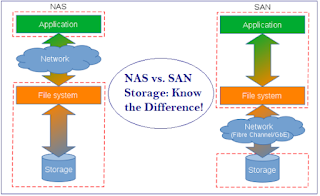NAS vs. SAN - Understanding the Major Differences!
Introduction
Do you know the difference between a NAS and SAN? You've probably heard of both, but do you know what sets them apart?
Both NAS (Network-Attached Storage) and SAN (Storage Area Network) are server storage solutions, but they differ in a few ways. Firstly, NAS connects directly to the network, while SAN requires a separate specialised network. Secondly, SAN is typically used for applications requiring high performance and reliability, such as databases or email servers. Lastly, NAS is generally less expensive than SAN.
So which one should you choose for your business? Let's take a closer look at both options.
In this blog post, we'll break down the differences between a NAS and SAN so that you can make an informed decision about which is best for your business. Stay tuned!
What is NAS?
NAS, or Network Attached Storage, is a type of storage device that connects to a computer network instead of a single computer. NAS devices are often used to store large amounts of data, such as music, videos, and photos. NAS devices typically come with their own software, which makes it easy to access and manage the data stored on them. NAS devices can be used by individuals and businesses alike. For businesses, NAS devices can be used to store sensitive data, such as customer information and financial records. NAS devices are also often used to back up data in case of a system failure.
Benefits of NAS
NAS storage devices offer a number of benefits over other storage solutions. NAS devices are specifically designed to be connected to a network, which allows them to be accessed by multiple users simultaneously. This makes NAS devices an ideal solution for small businesses or home offices that need to share data between multiple computers. NAS devices also tend to be more reliable than other storage solutions, as they are designed to operate in a 24/7 environment. And because NAS devices are self-contained, they are easy to set up and require no additional hardware or software. As a result, NAS devices offer an affordable and convenient solution for storing and sharing data on a network.
What is SAN?
SAN Storage, also known as a Storage Area Network, is a type of computer network that allows storage devices to be connected to servers. SANs are typically used in enterprise-level storage environments where high availability and performance are essential. SANs typically use Fibre Channel or iSCSI protocols to connect storage devices to servers. SANs can be implemented as either SAN appliances or SAN fabrics. SAN appliances are purpose-built SAN solutions that typically include both the SAN hardware and software. SAN fabrics are SAN solutions that use existing network infrastructure and components to create a SAN. Network SAN Storage is a type of SAN that uses Ethernet networking technology to connect storage devices to servers.
Benefits of SAN
SAN storage, or a storage area network, can provide numerous benefits for businesses of all sizes. SANs are networks that are dedicated to the storage and retrieval of data, and they can be used to connect multiple servers to a single storage device. This ensures that data is readily available and can be accessed quickly and easily. In addition, SANs can help to improve performance by reducing the amount of traffic on a company's primary network. They can also provide redundancy and fault tolerance, which is essential for businesses that rely heavily on data. Overall, SANs offer a number of advantages that make them an ideal solution for many businesses.
Conclusion
NAS and SAN are both great storage solutions, but there are some key differences that may make one a better fit for your specific needs. We hope this article has helped you understand the basics of each technology and which might be a better choice for you. If you’re still undecided or have questions, we would love to hear from you. Our team is experienced in both NAS and SAN deployments and can help you choose the right solution for your business.


Comments
Post a Comment